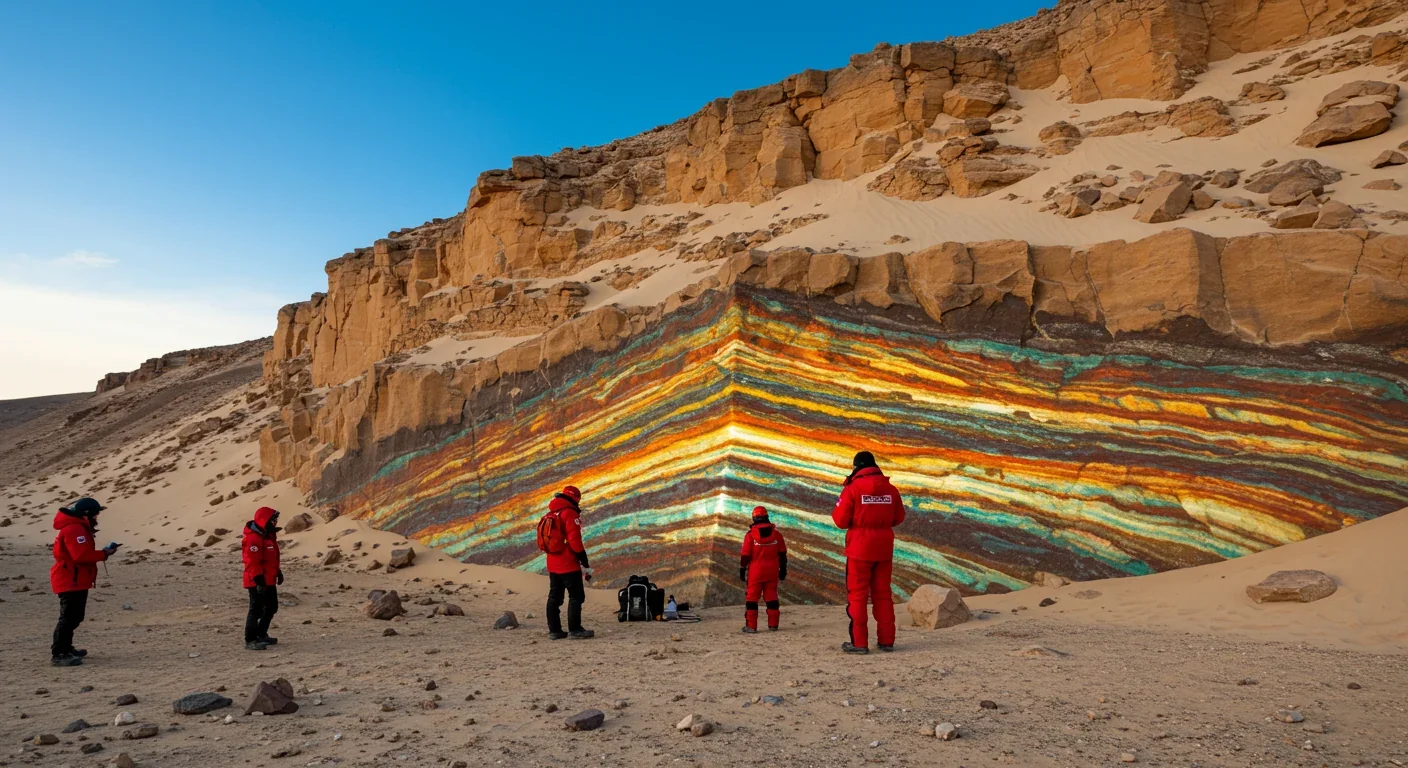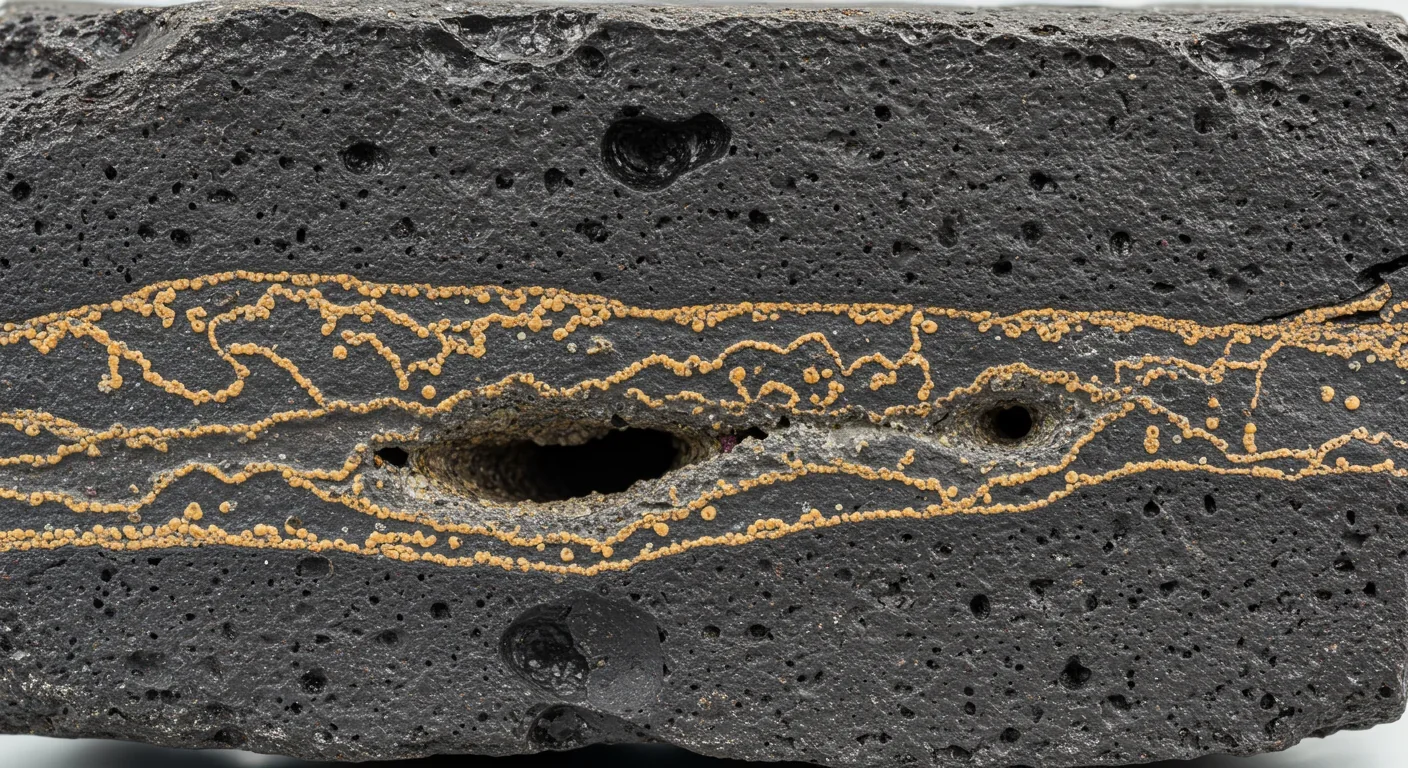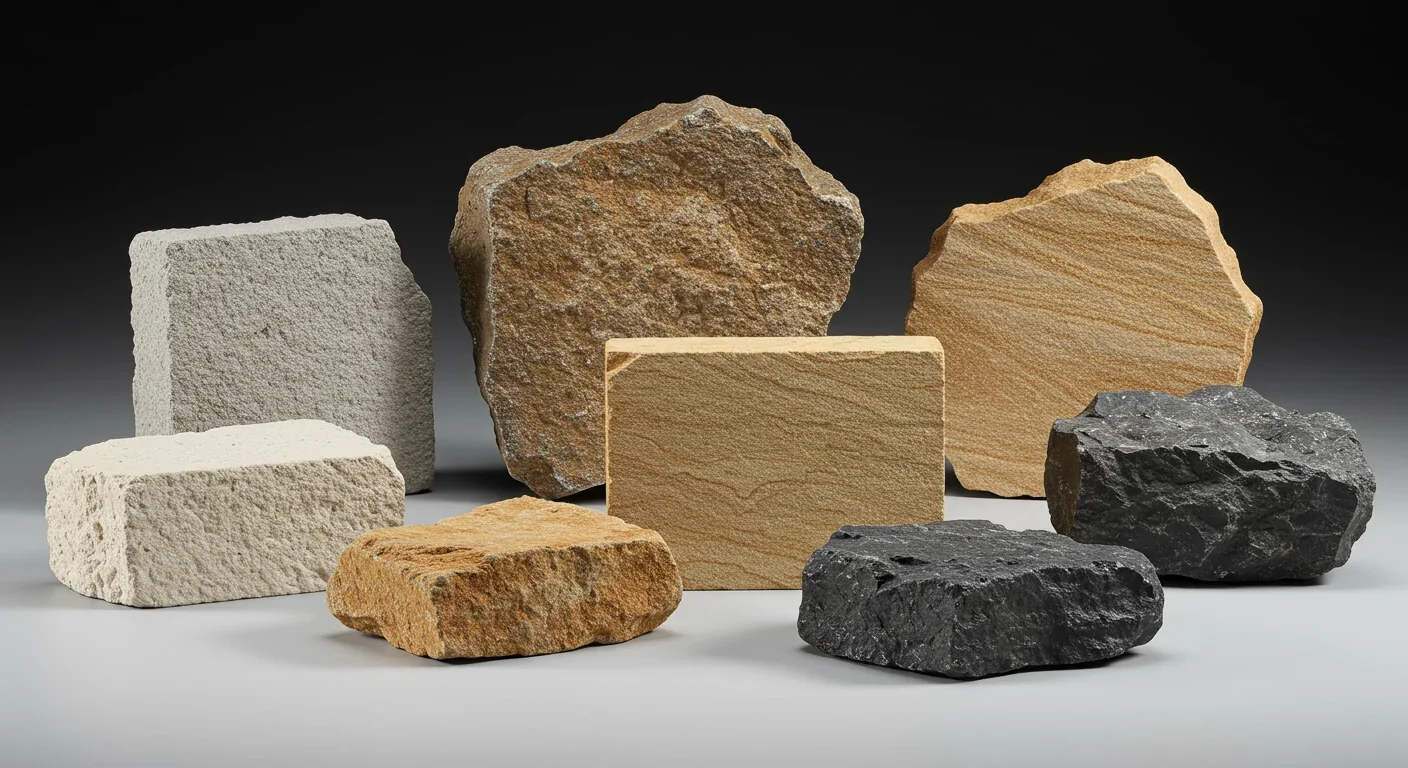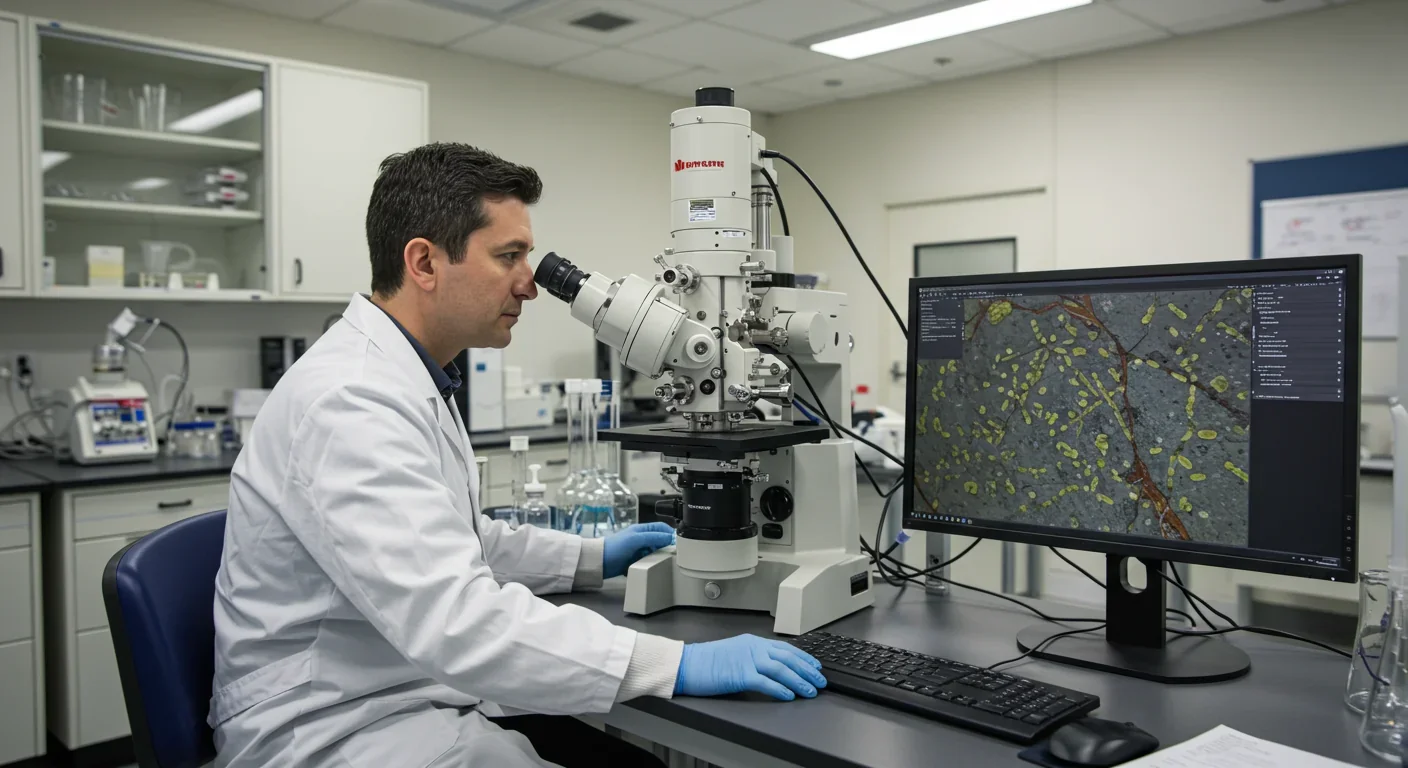Cuttlefish Pass Marshmallow Test: Alien Intelligence Decoded

TL;DR: Endoliths—microorganisms living inside solid rock—thrive in Earth's most extreme environments, from Antarctic deserts to deep ocean crust. Their existence rewrites habitability rules and transforms the search for extraterrestrial life.

Imagine drilling two miles into solid rock and finding life. Not fossils—living organisms, reproducing once every 10,000 years, feeding on gases seeping through microscopic fractures. These aren't science fiction creatures from a distant planet. They're endoliths, and they're everywhere, thriving in conditions that would annihilate most life on Earth. From the frozen deserts of Antarctica to the scorching ocean crust miles beneath the seafloor, these extremophiles are forcing scientists to rethink where life can exist—and what that means for finding it beyond Earth.
The discovery of endolithic communities challenges our most basic assumptions about habitability. While we've spent centuries studying life on Earth's surface, an entire hidden biosphere has been quietly persisting inside the planet itself. These organisms don't just survive in rock—they actively reshape it, boring tunnels, dissolving minerals, and participating in global cycles that affect everything from carbon sequestration to soil formation. Their existence suggests that the boundary between "alive" and "lifeless" is far more blurred than we ever imagined.
The term comes from Greek: endo (inside) and lithos (stone). But calling something an endolith is like calling something "a thing that lives in buildings"—it covers an astonishing diversity of life strategies. Bacteria, archaea, fungi, algae, and even lichens have all evolved ways to colonize the interior of rocks. Some squeeze into existing cracks. Others chemically dissolve their way through solid mineral. Still others settle into the pores between mineral grains, creating intricate three-dimensional communities invisible to the naked eye.
Scientists divide endoliths into five subclasses based on how they colonize rock. Chasmoendoliths exploit existing fissures and cracks, like squatters moving into abandoned buildings. Cryptoendoliths colonize the natural pore spaces between mineral grains—think of them as the apartment dwellers of the rock world. Euendoliths are the most dramatic: they actively bore into solid rock using chemical dissolution, leaving behind tunnels that match their body shape. Hypoendoliths live in pore spaces underground, often in groundwater aquifers or cave systems. Autoendoliths take a different approach entirely, depositing minerals around themselves and gradually becoming entombed in stone.
In 2025, researchers discovered ancient micro-burrows in marble and limestone estimated to be one to two million years old—the oldest morphological evidence of endolithic activity on Earth. The organism that created them remains unknown.
The euendoliths deserve special attention. These organisms don't wait for convenient living space—they make it. By secreting acids or other corrosive compounds, they chemically dissolve calcium carbonate, silicate minerals, or even basaltic glass, creating channels and grooves as they advance. In 2025, researchers discovered ancient micro-burrows in marble and limestone across Namibia, Oman, and Saudi Arabia—half a millimeter wide, up to three centimeters long, filled with calcium carbonate powder. The organism that created them? Still unknown. These subfossil tunnels are estimated to be one to two million years old, providing the oldest morphological evidence of endolithic activity on Earth.

Living inside rock solves some problems while creating others. The primary advantage is protection. Rock shields organisms from the three horsemen of microbial apocalypse: ultraviolet radiation, desiccation, and extreme temperature swings. A few millimeters of sandstone can reduce UV exposure by more than 99%, creating a livable microclimate even in hyperarid deserts like the Atacama or the Antarctic Dry Valleys.
But protection comes at a cost. Rock is not porous like soil or water. Nutrients are scarce. Oxygen can be nonexistent. Energy sources are minimal. So endoliths have evolved some of the most efficient metabolic strategies known to science. Many are chemolithotrophic—they generate energy by oxidizing inorganic compounds like iron, sulfur, or hydrogen sulfide. Some fix carbon from atmospheric CO₂, building organic molecules from scratch without any input from photosynthesis. Others have genes for nitrogen fixation, allowing them to manufacture essential nutrients from atmospheric nitrogen.
"Endoliths are the only organisms that can live for millions of years without reproducing, repairing cell damage caused by cosmic rays and other stresses."
— Friedmann et al., 2013
The most remarkable adaptation is time itself. Deep-sea endolithic bacteria in ocean floor basalt reproduce only once every 10,000 years. Their metabolic rates are so low that cell division becomes a geological event rather than a biological process. These organisms can survive for millions of years without reproducing, constantly repairing cell damage caused by cosmic rays and other stresses. They exist in a metabolic limbo between life and dormancy—a state that has no equivalent in surface ecosystems.
Some endoliths have found creative workarounds. Certain cyanobacteria colonize translucent rocks like gypsum and halite, using the mineral itself as a protective lens to capture enough light for photosynthesis. Cryptoendolithic lichens in Antarctic sandstone create layered communities where algae photosynthesize near the rock surface while fungi penetrate deeper, forming a symbiotic network that can persist for decades in one of Earth's harshest environments.
Endolithic communities have been documented on every continent and in nearly every rock type imaginable. Their distribution reads like a catalog of Earth's most extreme environments.
Antarctic Dry Valleys: The McMurdo Dry Valleys are among the coldest, driest places on Earth—so inhospitable that they're used as Mars analogs. Yet cryptoendolithic lichens thrive in sandstone here, creating colorful bands visible just beneath the rock surface. These communities have generation times measured in centuries, with individual colonies persisting for thousands of years.
Atacama Desert: The world's driest non-polar desert hosts endolithic bacteria and archaea in igneous and sedimentary rocks. Some sites receive measurable rainfall only once per decade, yet microbial communities persist in the rock interior, sustained by fog and dew that penetrate microscopic pores.
Deep Ocean Crust: Perhaps the most alien endolithic habitat is the volcanic rock of the ocean floor. The Ocean Drilling Program found microscopic trails in basaltic glass across the Atlantic, Indian, and Pacific oceans—DNA-laden tunnels created by glass-munching bacteria that extend up to 500 meters below the seafloor. These communities exist in complete darkness, under crushing pressure, feeding on chemical energy from hydrothermal circulation.
Deep Continental Crust: Endoliths have been found in South African gold mines at depths exceeding 3 kilometers, where temperatures approach 60°C and the rock is essentially sealed off from the surface. These organisms feed on hydrogen gas produced by water-rock reactions and on methane and other hydrocarbons migrating through fractures. Some communities are so isolated that they've been separated from surface ecosystems for millions of years.
Desert Varnish and Rock Coatings: In arid regions worldwide, thin mineral coatings on rock surfaces harbor endolithic microorganisms that contribute to the formation of desert varnish—those dark, shiny patinas on boulders and cliff faces. These communities mediate the deposition of manganese and iron oxides, creating geological features that persist for thousands of years.
The common thread across all these environments is stress. Endolithic niches are defined by what they lack: water, nutrients, oxygen, stable temperatures. Yet life not only persists but thrives, forming stable communities that can outlast entire civilizations.

Endoliths possess some of the most versatile metabolic pathways known to microbiology. A single community can include organisms using radically different energy sources, creating a biochemical network that would be impossible on the energy-rich surface.
Sulfur metabolism is common in volcanic rock endoliths. These organisms oxidize hydrogen sulfide or elemental sulfur, releasing energy that drives carbon fixation. The process mirrors what happens at deep-sea hydrothermal vents, but in a solid matrix rather than open water.
Iron oxidation provides energy for endoliths in iron-rich rocks like basalt. These microbes convert ferrous iron (Fe²⁺) to ferric iron (Fe³⁺), capturing the released electrons to power cellular processes. The result is visible rust-colored staining in colonized rocks.
Photosynthesis persists even inside rock, provided the stone is translucent enough. Cyanobacteria and algae colonize quartz, alabaster, and certain limestones, using filtered sunlight to produce organic matter that feeds the entire endolithic community.
Hydrogen metabolism dominates in deep subsurface environments. Water-rock reactions produce molecular hydrogen, which endolithic archaea and bacteria oxidize, often combining it with carbon dioxide to produce methane—a process called methanogenesis.
Nitrogen fixation has been detected in multiple endolithic communities, allowing them to convert atmospheric nitrogen into biologically available ammonia. This is energetically expensive but essential in environments where fixed nitrogen is otherwise absent.
The metabolic diversity suggests that endolithic ecosystems function as closed-loop systems, where the waste products of one organism become the food for another. This level of integration is more characteristic of mature, stable ecosystems than of the marginal survival niches we once imagined endoliths to occupy.
The discovery and characterization of endoliths has revolutionized the search for extraterrestrial life. Mars and the icy moons of Jupiter and Saturn suddenly look more habitable once you accept that life doesn't need a surface.
Mars is the most obvious application. The planet's surface is bathed in lethal UV radiation, experiences temperature swings of 100°C or more, and has had no standing water for billions of years. But a few centimeters below the surface, conditions are far more stable. Martian rocks—especially the basalts and sedimentary carbonates detected by rovers—could harbor endolithic communities if they ever existed. The 2025 discovery of ancient micro-burrows on Earth provides a template for what to look for: physical biosignatures that persist long after the organisms themselves are gone.
On Mars, where surface conditions are lethal, subsurface endolithic communities could have persisted for billions of years. The ancient micro-burrows discovered on Earth show that biosignatures can survive long after the organisms are gone.
Europa, Jupiter's ice-covered moon, presents another compelling scenario. Beneath its frozen shell lies a global ocean kept liquid by tidal heating. But between the ice and the ocean, there's likely a layer of mixed ice and rock—a chaotic terrain where endolithic life could exploit chemical energy from water-rock reactions. Similar environments might exist on Enceladus, which actively vents water vapor and organic compounds from a subsurface ocean.
Even more exotic are the silicate mantles of rocky exoplanets. If life can colonize rock 3 kilometers deep on Earth, there's no theoretical barrier to it existing even deeper on larger worlds with more intense geothermal gradients. This raises the possibility of "intraterrestrial" biospheres—planets where the majority of biomass exists not on the surface but within the crust itself.
The astrobiological implications extend beyond detection. Endoliths demonstrate that life can persist for geological timescales in energy-limited environments. This suggests that once life emerges, it might be nearly impossible to eradicate. Even if a planet's surface becomes sterilized by radiation, asteroid impacts, or atmospheric loss, subsurface refugia could allow life to endure until conditions improve.

Endoliths aren't passive inhabitants of rock—they actively transform it. Their metabolic activities drive chemical reactions that would otherwise occur only on geological timescales, effectively accelerating Earth's mineral cycling.
Rock weathering is perhaps their most visible impact. By secreting acids and other corrosive compounds, endoliths chemically dissolve minerals, contributing to the breakdown of rock into soil. This process releases nutrients like calcium, magnesium, and phosphorus, making them available to surface ecosystems. In some environments, biological weathering by endoliths exceeds purely physical or chemical weathering.
Carbon sequestration occurs when endoliths fix atmospheric CO₂ into organic matter that becomes buried in sediment. Some estimates suggest that subsurface microbial communities, including endoliths, sequester more carbon than all terrestrial forests combined. This "deep carbon cycle" plays a poorly understood but potentially crucial role in regulating Earth's climate over geological time.
Mineral formation happens when endoliths precipitate new minerals as byproducts of metabolism. Iron-oxidizing bacteria create iron oxide crusts. Sulfur-metabolizing organisms deposit elemental sulfur or sulfate minerals. Some endolithic communities even create entirely new mineral phases that don't form through purely inorganic processes.
Nitrogen cycling in oligotrophic (nutrient-poor) environments is often driven by nitrogen-fixing endoliths. By converting atmospheric N₂ into ammonia, they provide the foundation for entire ecosystems that would otherwise be nitrogen-limited. This process is especially important in deserts and polar regions.
Recent research suggests that endoliths may also influence global elemental cycles in unexpected ways. Microbes living in ocean floor basalt, for instance, may affect the ocean's iron budget, contributing to marine productivity thousands of kilometers away. Endoliths in continental crust might mediate the release of radiogenic gases like helium and radon, affecting atmospheric chemistry.
Finding life inside solid rock presents obvious challenges. You can't just look at a rock and see its microbial inhabitants. The first convincing evidence for endolithic life came in the 1970s, when microbiologist E. Imre Friedmann noticed colored bands inside Antarctic sandstones. When he examined thin sections under a microscope, he found layered communities of cyanobacteria, fungi, and algae living several millimeters below the rock surface.
Modern endolith research employs an arsenal of techniques:
Microscopy: Scanning electron microscopy (SEM) reveals the physical architecture of endolithic communities and their relationship to the rock matrix. Confocal microscopy using fluorescent dyes can visualize living cells deep within translucent minerals.
Molecular biology: DNA and RNA sequencing allows researchers to identify endolithic organisms without culturing them—essential because most can't be grown in lab conditions. Metagenomic approaches reveal entire communities and their metabolic potential.
Isotopic analysis: Stable isotope ratios of carbon, nitrogen, and sulfur can reveal metabolic pathways and food web relationships. Isotopic signatures also help distinguish biological weathering from purely chemical processes.
Drilling and coring: Ocean drilling programs and continental drilling projects recover rock cores from depths of several kilometers, preserving endolithic communities for analysis. Contamination control is critical—researchers must prove that any detected organisms actually came from within the rock rather than from surface or drilling fluid.
Imaging: X-ray tomography and other non-destructive imaging techniques allow researchers to see three-dimensional structure of endolithic communities without destroying the sample.
The 2025 discovery of subfossil micro-burrows in desert marble exemplifies how new questions emerge as methods improve. Using high-resolution scanning and isotopic dating, researchers identified tunnels created by an unknown euendolith between one and two million years ago. The organism itself is long gone, but its architectural signature remains—a biosignature that could potentially be detected by rovers on Mars.

The extremophile enzymes and metabolic pathways found in endoliths have attracted attention for several practical applications:
Bioremediation: Endolithic bacteria that thrive in contaminated aquifers could be harnessed to break down heavy metals, radioactive isotopes, or organic pollutants. Because they're adapted to nutrient-poor conditions, they might succeed where surface microbes fail.
Biomining: Endoliths that dissolve rock to access nutrients could be applied to extract valuable metals from low-grade ores. Bioleaching using endolithic organisms could make previously uneconomical mineral deposits viable while reducing the environmental impact of conventional mining.
Biomanufacturing: Enzymes from endoliths function under extreme conditions—high pressure, low temperature, minimal water. These properties make them attractive for industrial processes where conventional enzymes fail.
Carbon capture: Understanding how endolithic communities fix and sequester carbon could inform strategies for enhanced mineral carbonation—a process where CO₂ is permanently locked into carbonate minerals.
Astrobiology tools: Methods developed to detect and study endoliths on Earth directly inform instrument design for Mars rovers and landers. The search for life on other planets increasingly focuses on subsurface environments where endolithic communities might persist.
Cultural heritage preservation: Ironically, some endoliths damage stone monuments and buildings, while others protect them by forming protective mineral coatings. Understanding these processes is crucial for conserving archaeological sites and historic structures.
When did endolithic life first appear? The question has no clear answer, but the implications are profound. If life began in surface environments like tidal pools or hydrothermal vents, then endoliths represent a secondary colonization of subsurface niches. But some researchers have argued the opposite: that life originated in subsurface environments where it was protected from asteroid impacts and intense UV radiation, and only later colonized the surface.
The deep, hot biosphere discovered in continental and oceanic crust might represent a relic of this early subsurface life—organisms that never left their original habitat even as more energy-rich surface environments became available. Molecular clock analyses suggest that some of the deepest-branching lineages on the tree of life are thermophiles and chemolithotrophs—exactly the metabolic profiles you'd expect from early endoliths.
"These organisms challenge our understanding of where life can survive."
— Biology Insights
The subfossil micro-burrows discovered in 2025, at one to two million years old, are nowhere near the oldest evidence of endolithic life. Fossilized boreholes in rocks from the Precambrian—over 500 million years ago—show remarkably similar morphologies, suggesting that euendolithic lifestyles evolved early and have remained stable across geological time.
This stability is itself significant. While surface ecosystems have undergone radical transformations—from anoxic to oxygen-rich atmospheres, from ice ages to greenhouse periods, from microbial mats to forests—endolithic communities have persisted in essentially unchanged form. They represent a kind of evolutionary conservatism, a strategy so successful that it needs no refinement.
Several frontiers are driving current research:
Deep biosphere exploration: Drilling projects are pushing deeper into the crust, seeking the limits of life. Current records extend past 5 kilometers, but theoretical models suggest life might exist as deep as 10 kilometers in favorable conditions. Each new drilling campaign reveals previously unknown organisms and metabolic pathways.
Mars sample return: NASA and ESA are planning missions to return rock samples from Mars. These samples will be examined for evidence of endolithic life—either active organisms or fossil biosignatures. The techniques being refined to detect Earth endoliths will be directly applied to Martian samples.
Synthetic endolithic communities: Researchers are attempting to create artificial endolithic ecosystems in laboratory rock samples. These experiments test hypotheses about colonization mechanisms, metabolic interactions, and response to environmental stress. They also inform the design of life-support systems for long-duration space missions.
Ancient Earth analogs: By studying modern endoliths in extreme environments, researchers gain insight into what early Earth ecosystems might have looked like. Endoliths in Antarctic Dry Valleys, for instance, provide analogs for Snowball Earth periods when the planet's surface was largely frozen.
Biotechnology development: As genomic and proteomic databases grow, researchers are identifying enzymes and metabolic pathways with industrial applications. The next generation of biomining and bioremediation technologies will likely draw heavily on endolithic organisms.
The broader significance of endolithic life extends beyond microbiology or astrobiology. These organisms force us to reconsider fundamental questions: What is a habitable environment? Where are the boundaries of the biosphere? How resilient is life in the face of planetary-scale catastrophes?
Endoliths demonstrate that habitability is not binary—it's a spectrum. The Antarctic Dry Valleys, the deep ocean crust, and the Atacama Desert are "uninhabitable" by surface standards, yet they host thriving ecosystems. This realization has implications for everything from planetary science to climate change resilience. If life can persist in rock, it can probably survive almost anything short of complete planetary sterilization.
They also reveal the incompleteness of our biological census. Despite centuries of taxonomy and ecology, we're still discovering entirely new categories of life in environments we previously dismissed as lifeless. The 2025 discovery of million-year-old micro-burrows created by an unknown organism is a reminder that Earth still holds profound biological mysteries.
Finally, endoliths embody a different relationship between life and geology. On the surface, geology provides the stage and biology performs. But in endolithic ecosystems, the distinction blurs. Life becomes geology—drilling tunnels, dissolving minerals, precipitating new compounds. The rock is simultaneously habitat, barrier, resource, and product. This intimate entanglement suggests that on any planet with liquid water and chemical energy, life and geology will co-evolve in ways we're only beginning to understand.
In a universe where solid rock is common and surface water is rare, endolithic life might be the norm rather than the exception. The hidden world beneath our feet could be a window into the most common form of life in the cosmos—organisms we've overlooked because we've been looking up instead of down.

Curiosity rover detects mysterious methane spikes on Mars that vanish within hours, defying atmospheric models. Scientists debate whether the source is hidden microbial life or geological processes, while new research reveals UV-activated dust rapidly destroys the gas.

CMA is a selective cellular cleanup system that targets damaged proteins for degradation. As we age, CMA declines—leading to toxic protein accumulation and neurodegeneration. Scientists are developing therapies to restore CMA function and potentially prevent brain diseases.

Intercropping boosts farm yields by 20-50% by growing multiple crops together, using complementary resource use, nitrogen fixation, and pest suppression to build resilience against climate shocks while reducing costs.

Cryptomnesia—unconsciously reproducing ideas you've encountered before while believing them to be original—affects everyone from songwriters to academics. This article explores the neuroscience behind why our brains fail to flag recycled ideas and provides evidence-based strategies to protect your creative integrity.

Cuttlefish pass the marshmallow test by waiting up to 130 seconds for preferred food, demonstrating time perception and self-control with a radically different brain structure. This challenges assumptions about intelligence requiring vertebrate-type brains and suggests consciousness may be more widespread than previously thought.

Epistemic closure has fractured shared reality: algorithmic echo chambers and motivated reasoning trap us in separate information ecosystems where we can't agree on basic facts. This threatens democracy, public health coordination, and collective action on civilizational challenges. Solutions require platform accountability, media literacy, identity-bridging interventions, and cultural commitment to truth over tribalism.

Transformer architectures with self-attention mechanisms have completely replaced static word vectors like Word2Vec in NLP by generating contextual embeddings that adapt to word meaning based on surrounding context, enabling dramatic performance improvements across all language understanding tasks.